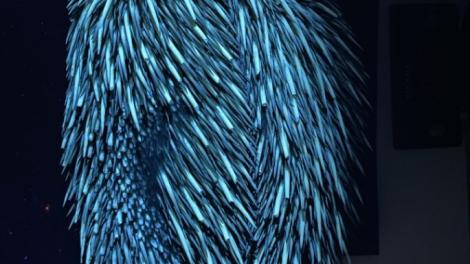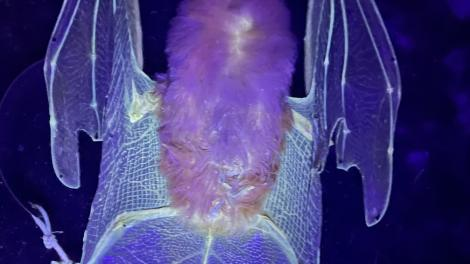In a study of more than 100 species of mammals, all but one were found to glow externally when exposed to UV light; even the exception, the dwarf spinner dolphin, has fluorescent teeth. Nevertheless, not all species fluoresce to the same extent, with white fur being a strong predictor of blacklight glow.
Fluorescence is the absorption of light and re-emission at longer wavelengths, particularly absorbing UV and glowing in humans’ visible range. The discovery it is common among mammals, particularly marsupials, is a recent one largely because for decades few people had bothered to look. After all, in nature UV light is restricted to the daytime, when any fluorescence will be invisible, overwhelmed by all the brighter wavelengths.
Then in 2019, some researchers discovered that flying squirrels glow pink under UV light. Two years later we learned platypus glow green in the same conditions. While other people spent their lockdowns learning a new language or baking bread, Dr Kenny Travouillon of the Western Australian Museum ran a UV light over some of his employer’s specimens and discovered fluorescence is very common.
Now, Travouillon and colleagues have made their work more systematic, exploring which mammalian species fluoresce and how much. They recorded 125 species of mammals within the museum’s collections that fluoresced to some degree.
It seems fluorescence is universal for white fur, although they acknowledge they haven’t confirmed it with lemurs. Thus, when it comes to fluorescing, polar bears are probably the champions. Pigmented fur doesn’t usually fluoresce unless it is yellow, but even dark-furred animals glow a bit, for example around their toes, Travouillon told IFLScience. In some cases, it’s the toenails that glow.

For most mammals it is fur, but for echidnas it is their spines, formed from similar materials, that glow under UV light
Image Credit: WA Museum
“There was a large amount of white fluorescence in the white fur of the koala, Tasmanian devil, short-beaked echidna, southern hairy-nosed wombat, quenda, greater bilby, and a cat – and while a zebra’s white hairs glowed, its dark hairs did not,” Travouillon said in a statement. After white, the most common glow was yellow. Green, blue, red, pink, and orange were all observed, but the last three are rare.
One thing the team needed to check was whether this was real fluorescence, or optical scattering, which can look similar. Using specimens from several species, they shifted the wavelength of the UV applied and looked to see if the emission spectrum shifted. It didn’t, confirming what they are seeing really is fluorescence. Nor is it an effect of preservation techniques. Frozen samples of several species glowed more brightly before they were preserved, although, curiously, platypus went the other way.
Although fluorescence is more extensive for nocturnal marsupials than diurnal ones, its ubiquity strengthens the case that there is no evolutionary benefit. Instead, this may be a strange by-product of the molecules in fur that no one noticed until humans invented UV lights, although it’s possible some animals developed enhanced versions for sexual signaling.

The orange leaf-nosed bat’s glow is disappointingly not orange, but it’s impressively bright
Image Credid: WA Museum
Humans are mammals, and it turns out we fluoresce too. The glow of teeth is familiar to those who’ve attended blacklight nightclubs, but the fact that blonde and white hair also fluoresces was first documented in a scientific paper in 1911. Awareness wasn’t widespread, however, which Travoillon speculated to IFLScience was because “Not a lot of white-haired people go to nightclubs, and blonde hair [glows] so faintly it’s hard to see compared to white t-shirts, which they put a lot of chemicals in.”
It’s not just a mammalian trait either. All parrots fluoresce. “I tried it on my cockatiels and found the yellow feathers glow orange under UV,” Travouillon told IFLScience. Many other birds do as well, as do some reptiles, leading Travouillon to endorse IFLScience’s speculation dinosaurs probably did as well, a plot idea we’re happy to offer future Jurassic World scriptwriters.
The study is published in Royal Society Open Science.
Source Link: From Wombats To Polar Bears, All The Best Animals Glow Under UV Light